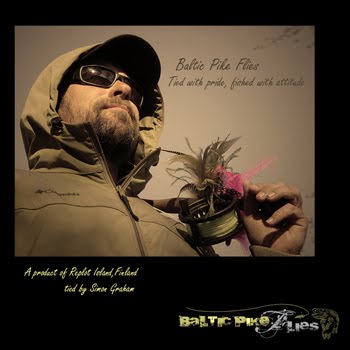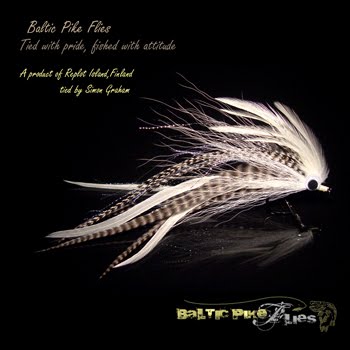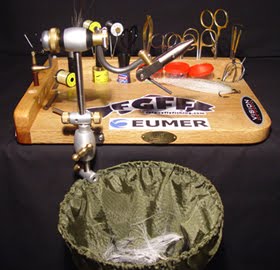 Having been an avid Saltwater fly-fisherman for many years in South Africa I eventually crossed over to Fly-fishing for Pike once I moved back to Europe in 95 & two of the main aspects I have had to change with regards to fly-fishing for this species was not only having to deal with learning how to chuck much large flies but I have also had to change the way I retrieved the fly as well.
Having been an avid Saltwater fly-fisherman for many years in South Africa I eventually crossed over to Fly-fishing for Pike once I moved back to Europe in 95 & two of the main aspects I have had to change with regards to fly-fishing for this species was not only having to deal with learning how to chuck much large flies but I have also had to change the way I retrieved the fly as well.Saltwater fly-fishing to me although as technical as any other form of Fly-fishing didn’t need much finesse. Sure, any saltwater fly-fisherman who has fly-fished for bonefish off the flats in Cuba will tend to disagree but overall I found the art form a tad slap n dash. Warmer, clearer water played a big part in why my retrieval was fast and furious, and off course obviously the species I was targeting, Barracuda, Garrick, Salmon, Jack Trevally, Shad (Tailor), Stump nose.
When I moved back to the U.K and started Fly-fishing for pike I brought the same gung-ho approach, and spent the good part of 2 seasons with very few fish to show for it, and so a drastic change in my approach was needed in order for me to become more successful as a pike fly-fisherman.
So I started reading as much literature as I could find, about my intended quarry the Elusive “Esox Lucius”. Something I encourage all novice Pike fly-fishermen to do.
With living in the tropics all those years I hadn’t taken into consideration the changes of season, which are more apparent in Northern Europe and thus have a much more adverse affect on not only the Pikes feeding habits but also its metabolism and general movement habits during each of these seasons.
After a month or so of reading I set about practicing different retrieval techniques at different speeds & depths, And it wasn’t long before I started to reap the benefits.
About two years ago I was float tubing on a smaller stretch of water in the forests here in Kuru Finland and It suddenly dawned on me while stripping back my fly that Fly-fishing for Pike was, if not very similar to the other passion in my life “Cricket”.
Now I know what you’re thinking…Simon you’re talking a load of bollocks, but if you stop and think about it for a moment my words aren’t that far from the truth.
Trying to explain the game of cricket to a layman can take day’s even months. (Which batsmen battles against a spin attack? Whether to bowl left arm over the wicket? How many fielders should be placed in the slips or on the off side? When should the captain declare his team’s innings?) The list goes on & on and even then, until they have sat down and watched a five-day test, enjoyed it, and understood all the games subtle nuances will they have a better appreciation of the game. The same principle applies with Pike fly-fishing. (What fly to use? Surface or fast sinking, Flash streamer or a white/black bodied Bunny. What fly works best with the line you are using at that specific place you are fishing? Whether to use a floating or intermediate line. How long should one let a fast sinking line drop before retrieval? Should I retrieve the fly fast or slow? What action can you impart on the fly with the line you are using with the retrieve you use?
The list went on and on, and even now after 14 years of fly-fishing for pike I find myself learning every time I venture out.
Here in Finland especially the Southern parts many of the lakes Are extremely dark due to the run of from the hundreds and thousands of bogs, which litter its landscape. For a pike fly-fisherman this makes the effort of chucking some fluff with the chance that a Pike will spot your fly even harder. Added to that, time of year, depth & area fished will eventually all come down to how well presented your fly is in the water. In Northern Finland (Lapland) the lakes are for want of a better word ‘crystal clear’ and so it is possible to not only get away with using much darker flies but your retrieval of that fly can be far more quicker & erratic due to the Pike having much better visibility. Also waters that far north never really get over warm and so during the short season Pike can be found at all depths and are extremely active.
Winter Piking
In General though Pike fly-fishermen have to contend with two main seasons Winter & Summer and with both seasons come different challenges. I found while living in the UK whether I was fishing in Ireland, Scotland or England that during the winter months the slower the retrieval the better. The question is “How slow is slow?” Well depending on where & what stretch of water you are fishing will depend on quite few many factors. Let’s take for instance canals. These stretches of water aren’t particularly deep and so I would use an Intermediate slow sinking line and count down until I knew the fly was lying on the bottom. This would take anywhere between 10 to 20 seconds. I would then begin to strip back the fly 10cm at a time for at least 4 strips and every now and then a longer strip of around 20 cm. I also have got in to the habit of raising the tip of my rod straight after this longer strip either to the left or to the right. This too imparts another angle of movement in the fly instead of just a straight-line movement back to the shore you are fishing from. Once you have worked the fly across that stretch of water, recast backs across the canal but two metres either side of where you last entered the water. This time count down half the time it took to hit the bottom and start your retrieval. Look at it as if you have a left-hander at the crease and maybe a right arm spin bowler would fair better against him. Always be prepared to try something different I say. This time strip back in 20cm lengths, with every fifth one being a 10cm strip, Remember to raise your rod tip after this short pull. Lowering your rod tip again puts just enough slackness back in the line for your fly to flutter down again before your next 20cm strip. I also encourage to you to get in to the habit of stopping In the middle of a strip every now and then. Over the last few years I have noticed that many of my takes have been during this period where the fly has stopped, so stay alert!
Spring Piking
Springtime for me here in Finland brings new revitalised energy to my Fly-fishing. Here in Southern Finland most lakes thaw out in early April with Pike spawning As soon as they can get close into the shallows and reed bed areas. This period lasts for around two weeks.
This is probably one of the best and most productive times to go Pike fly-fishing here. Pike are ravenous and in my experience just as aggressive as in late autumn. Pike lie close into the shoreline and I am often toiled with the problem of whether to use a floating line or a slow sinking intermediate. As Pike feed at all depths during this period I usually use an Intermediate slow sinking line with a surface lure to start proceedings (Poppers, Ballydoona bombers or even a Bunny-wobbler) Although your line sinks slowly, the short 20cm strip you give imparts a wonderful action in your fly which become irresistible to any Pike lying anywhere in its close proximity. Vary the length of your strip here 10cm, 20cm, and 30cm at a time. The longer the strip the longer the fly will stay under water and its rise to the surface will also be longer. Always try remembering to every now and then raise and lower your rod tip from right to left and stop the retrieve every 3 to 6 strips. If it’s an all day session I invariably swap over to a floating line with a fast sinking fly and fish 3m to 8m from the margins. Although the front 4 metres of your floating line sinks with the fast sinking fly attached the action is opposite with the fly rising and sinking in short 10, 20 & 30cm lengths. (Most takes will be as the fly sinks back down).
Summer Piking
Summer time here in Finland is like most other places in Europe extremely hard for the Pike fly-fisherman. Pikes have now moved into deeper water around the 5m to 10m depths due to the rise in the waters temperature at the surface, & the oxygen levels dropping off.
A fast sinking line here is needed coupled with a fast sinking fly. A fly preferably with a lot of flash built in. As I have mentioned before the lakes here in Finland are quite dark and fishing at these depths I want to give myself all the chance I can for a pike to see my fly. The Pike will still be active and quite aggressive but it’s getting down to them that put many a Pike fly-fishermen off.
The last two yrs though I have been employing a different tactic while fishing at depths. I take two rods on the Boat, fishing from either side of it. I cast the 1st line out 10m to 15metres over a respected drop off with a fast sinking line with a fast sinking fly attached allowing it to fall down into the respected area and then place it in a rod holder, then while that is sinking I then move to the other side of the boat and with the same set up (Fast sinking line/fast sinking fly) cast out 10m to 15m over the drop off. This would have given the 1st fly time to sink to a reasonable depth. Place the rod in the Holder. Now I start to retrieve the fist rig. With this method I am able to use extremely large flies of around 20cm to 25cm in length, as I don’t need to cast them all that far.
I start by stripping lengths of between 30cm and 60cm stopping in between each strip allowing the fly to slowly flutter back down. I also raise the tip of my rod either left or right a lot more with this method. To be honest I still haven’t caught any monsters using this method but I have regularly had fish in the boat between the 4.5kg & 6.5kg range. This I put down to not finding the right drop off yet but my day will come, as it will with you all. Sure its not classic fly-fishing in the true sense but it brings results especially on those days when it’s hot and all you want to do is feel the fly line between your fingers. Once I have retrieved the fly back up to the surface I cast it out 2m either side from its last position and start retrieving the other rods fly. Other than that during the summer months Pike fly-fishing should be practiced either in the early morning or very late afternoon/evening.
Autumn piking
Autumn time here is by far the most prolific and productive season for fly-fishing for pike. It’s a chance for me to go out onto a lake armed with just a box of Poppers and my favourite fly the Ballydoona Bomber. But that’s another article altogether.
By Simon Graham
Wilderness predator fly-fishing in Finland
www.freewebs.com/uivelonkierros





























0 comments:
Post a Comment